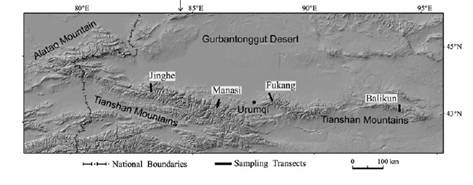Research of Soil Properties at Tree Limits of Coniferous Forest in Response to Varying Environmental Conditions in Tianshan Mountains, Northwest China made progress
2011-06-13
Continuous coniferous forest in Tianshan Mountains primarily consists of Picea schrenkiana. The forest forms an unbroken 1,000 km forest zone extending from west to east on the northern slope of Tianshan Mountains, where environmental conditions such as precipitation, temperature and terrain vary greatly. To gain insight into the differences between soil properties at the upper and lower limits of P. schrenkiana, Dr. Xu Wenqiang, Xinjiang Institute of Ecology and Geography, Chinese Academy of Sciences, studied the soil underlying the forests along 4 transects located at Jinghe, Manasi, Fukang, and Balikun, where the natural conditions are typical and therefore representative of western, mid-western, mid-eastern and eastern portions of Tianshan Mountains.
The soil type under the coniferous forest on the northern slope of Tianshan Mountains is gray cinnamon forest soil. For each transect, soil samples were collected from three different depths (0–5, 5–30 and 30–70 cm) in the area near the upper and lower limits of P. schrenkiana. A total of 48 soil samples were collected from 16 soil profiles and analyzed in two different laboratories. The soil pH, organic matter , total N, total P, CaCO3, and electrical conductivity were analyzed using common pedological methods. The continuous distribution of P. schrenkiana on the northern slope of Tianshan Mountains was caused by combined water-heat conditions and pedological factors. At the upper and lower tree limits, where differences existed in the soil parent materials, precipitation, topography, combined water-heat conditions, and local atmospheric pattern, the soil properties showed a close relationship with the local environmental conditions. Due to the presence of high precipitation over the Manasi transect, the soil was fertile and had a low CaCO3 content. In contrast, low soil fertility with high CaCO3 was observed in the soil along the Jinghe and Balikun transects, where there was low precipitation. Although the soil properties varied on the northern slope of Tianshan Mountains due to the presence of different environmental conditions across the 1,000-km forest zone, this region was suitable for the growth of P. schrenkiana. Taken together, the results of this study indicated that soil played an important role in controlling the continuous distribution of the P. schrenkiana along the northern slope of Tianshan Mountains.
The result was published in Environ Earth Sci, 2011, 63: 741–750. doi: 10.1007/s12665-010-0745-6.

Fig. 1 Sketch map of the northern slope of Tianshan Mountains and sampling transects



